Hemis Monastery is a magical place tucked away in the beauty of Ladakh. It’s one of the biggest and most famous monasteries there, and it’s been around for a really long time. People come from far and wide to learn about Buddhism and see the amazing things inside.
The monastery is like a beautiful palace with colorful paintings, fancy wood carvings, and lots of prayer flags. Every year, they have a huge festival with dancing, singing, and special ceremonies.
How to reach:
By Air:
The closest airport is in Leh, Ladakh. You can fly there from major Indian cities like Delhi, Srinagar, and Mumbai. From Leh, you can take a taxi or pre-booked car to Hemis Monastery.
By Road:
You can drive to Ladakh from Srinagar or Manali. The journey takes about 2 days from Srinagar and 2-3 days from Manali. Hemis Monastery is around 45 kilometers from Leh, a one to one and a half hour drive.
By Bus:
There are buses from Leh to different parts of Ladakh, including Hemis. Check the bus schedule and book tickets in advance.
Best Time to Visit:
The best time to visit Hemis Monastery is between June and September when the weather is pleasant. Winter can be very cold, so be prepared if you visit between October and March.
Best time to visit:
Summer (June to September)
Summer is the most popular time to visit Hemis Monastery. Enjoy pleasant weather with clear skies, perfect for exploring. This is also when the lively Hemis Festival takes place, offering a unique cultural experience.
Autumn (October)
Autumn brings cooler temperatures and fewer crowds. The landscape is stunning with autumn colors, making it ideal for trekking and enjoying the peaceful atmosphere.
Winter (November to March)
Winter in Ladakh is harsh with freezing temperatures and snow. While it offers a serene, snowy landscape, travel can be challenging due to closed roads.
Spring (April to May)
Springtime brings warmer weather and blooming landscapes. Roads become accessible as the snow melts, making it a pleasant time to visit before the summer crowds arrive.
Attractions:
Main Prayer Hall (Dukhang):
The heart of Hemis Monastery is its main prayer hall, a magical place filled with beauty and peace. Inside, you’ll see amazing paintings on the walls that tell stories about Buddha and other important people. There’s a huge statue of Buddha right in the middle, surrounded by smaller statues of special figures. The room is full of colorful pictures called thangkas that show important stories and people from Buddhism. It’s like stepping into a world of magic and wonder.
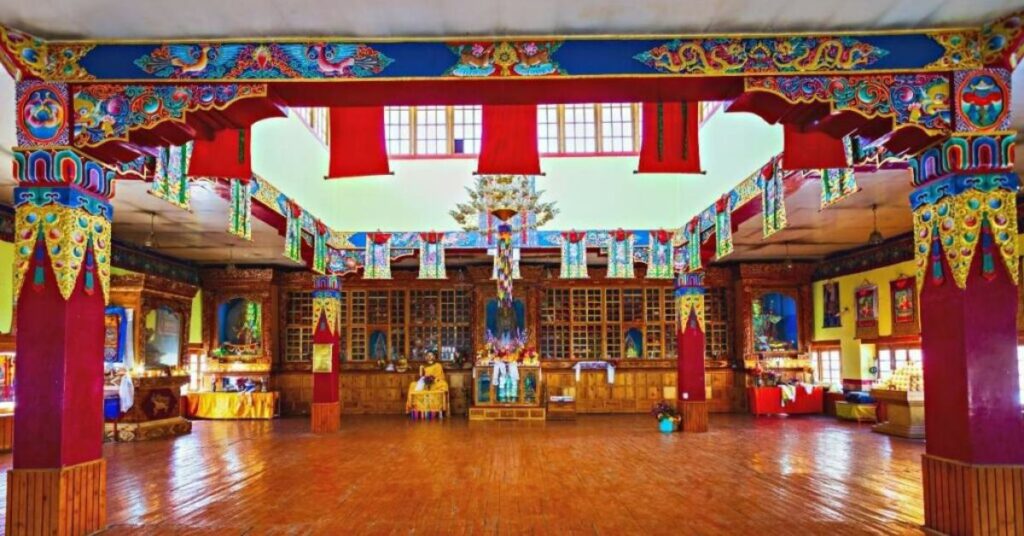
Hemis Festival:
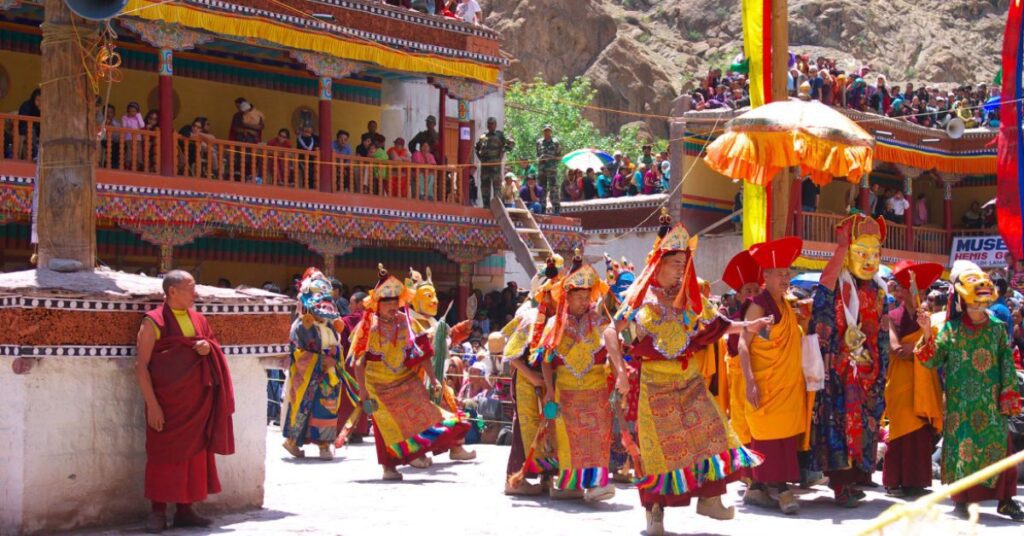
The Hemis Festival is a big, colorful party in Ladakh that happens every year. It’s a special time to honor a very important person in their religion. Monks wear funny masks and dance to tell stories about good winning over bad. People from all over come to watch the dancing and be part of the fun. It’s a great way to learn about Ladakh’s culture and traditions.
Museum:
The Hemis Monastery museum is like a treasure chest filled with amazing old things. You can find beautiful old books with fancy writing, special masks used in ceremonies, and other important things used in Buddhist prayers. There are also very special pictures called thangkas that tell stories about Buddha. It’s like stepping back in time and learning about the history and magic of Buddhism.
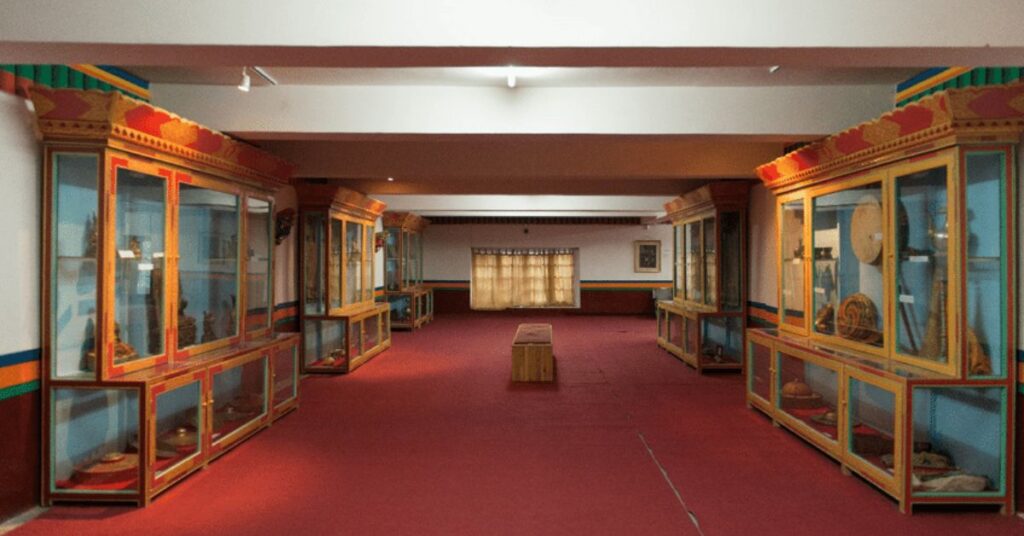
Assembly Hall (Gompa):
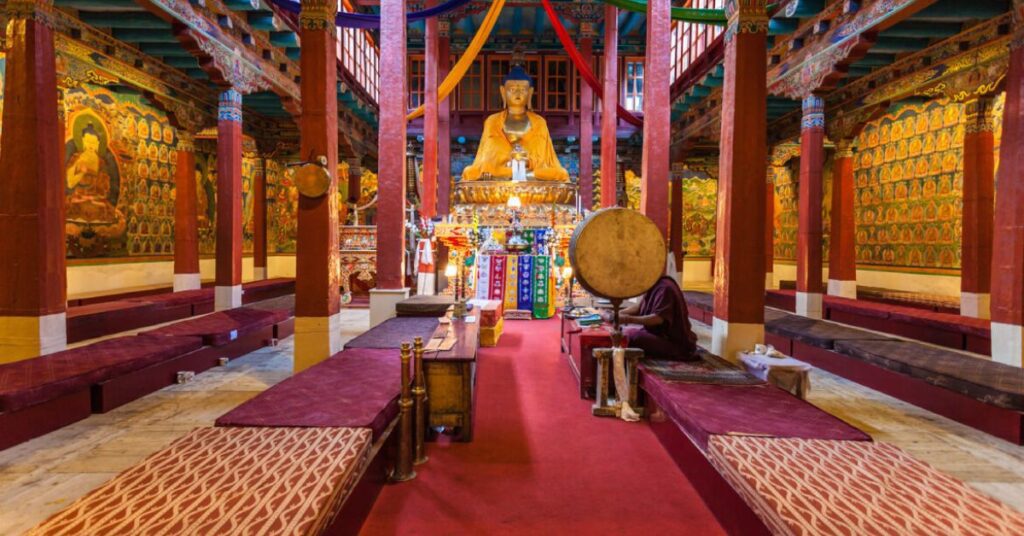
The Assembly Hall is the heart of Hemis Monastery where monks come together to pray and do special ceremonies. It’s a beautiful room with fancy wooden pillars and pretty pictures on the walls that tell stories about Buddha. When you’re there, it feels very peaceful and calm. It’s a special place where you can feel connected to the monks and learn about their beliefs.
Buddhist Stupas (Chortens):
Around Hemis Monastery, you’ll see special buildings called stupas. They’re like colorful little houses with pretty pictures and flags. Inside, there are special things like old books or other important items. People walk around the stupas while saying prayers. It’s a peaceful way to connect with the monks and learn about their beliefs.
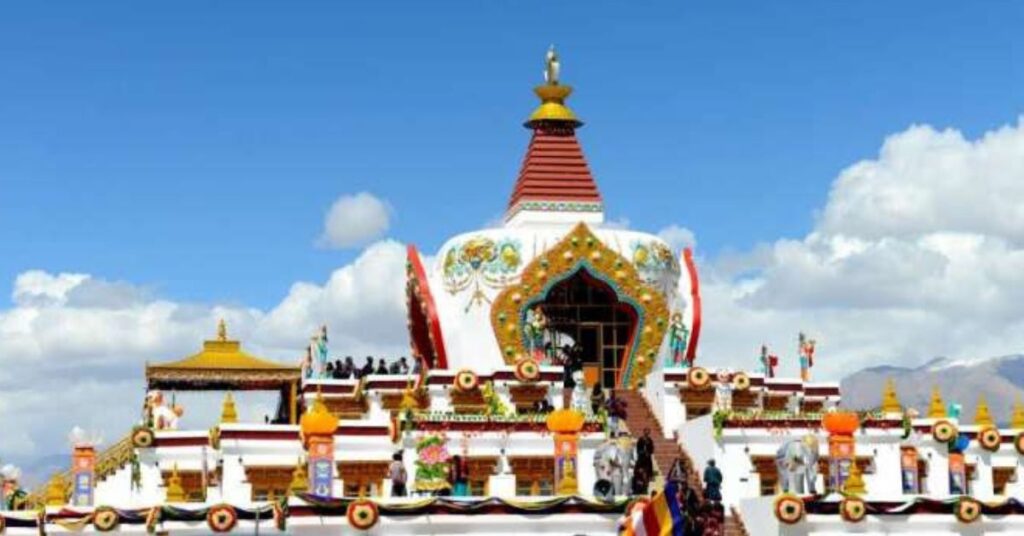
Hemis National Park:
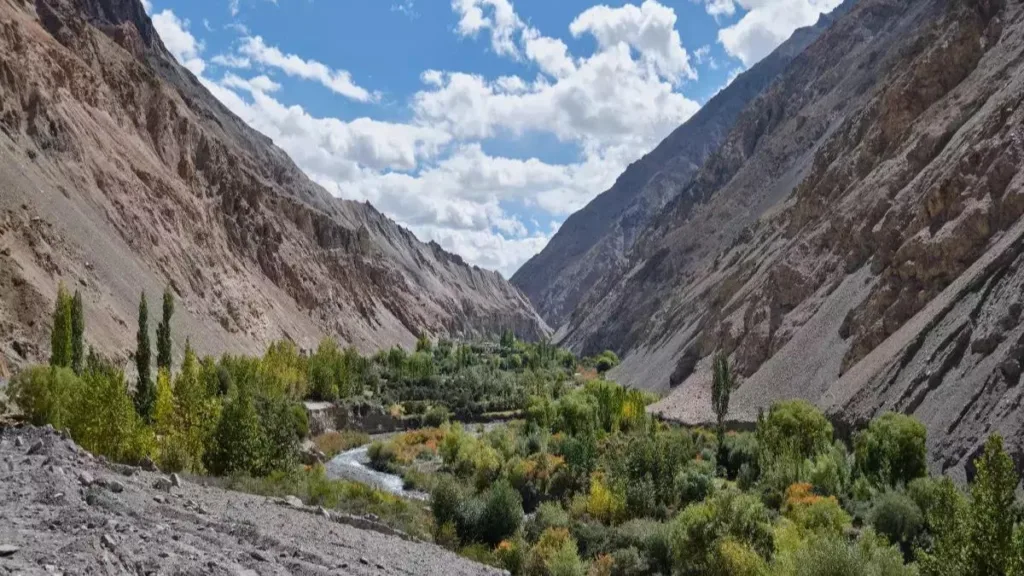
Ladakh’s wilderness awaits at Hemis National Park! This vast park shelters fascinating wildlife like the endangered snow leopard and Tibetan wolf. Explore the park on a wildlife safari, trek through diverse landscapes, or go birdwatching. From alpine meadows to crystal-clear lakes and snow-capped mountains, Hemis National Park offers a pristine wilderness experience for nature enthusiasts.
Local Experiences:
- Join the festival fun: Experience the excitement of the Hemis Festival with its colorful dances and music.
- Discover local crafts: Buy unique souvenirs and learn about traditional Tibetan crafts.
- Immerse in village life: Explore nearby villages to understand Ladakhi culture and hospitality.
- Connect with spirituality: Observe or participate in monastic rituals for a deeper spiritual experience.
- Savor local flavors: Try delicious Ladakhi food at local restaurants.
- Learn from the experts: Join a guided tour to learn about the monastery’s history and significance.
- Meet the monks: Interact with monks to understand their life and beliefs.
- Explore local markets: Find unique treasures and experience local life.
- Learn new skills: Attend workshops on traditional Tibetan crafts.
- Enjoy the peace: Take a leisurely walk and appreciate the beautiful surroundings.
Travel tips:
- Get the right permits: Make sure you have the necessary permits to visit Ladakh.
- Book accommodation early: Especially during peak season (June to September).
- Pack warm clothes: Even in summer, it can get chilly.
- Be prepared for altitude: Drink plenty of water and take it easy at first.
- Hire a car or taxi: This is the best way to get to Hemis Monastery.
- Consider a guided tour: For a deeper understanding of the monastery.
- Dress appropriately: Cover your shoulders and knees when visiting religious sites.
- Ask before taking photos: Respect the privacy of others.
- Bring a first aid kit: Be prepared for any minor injuries.
- Protect yourself from the sun: Use sunscreen and sunglasses.
- Carry enough cash: ATMs might be limited.
- Stay hydrated: Drink plenty of water.
- Be mindful of the environment: Dispose of waste properly.
- Know who to contact in case of emergencies.
Conclusion
A visit to Hemis Monastery on Xplro.com is more than a sightseeing trip; it’s an immersive journey into the heart of Tibetan Buddhist culture and Ladakhi heritage. The monastery’s awe-inspiring architecture, vibrant festivals, and serene surroundings create an atmosphere that is both spiritually uplifting and culturally captivating. Whether you’re drawn to the intricate artistry of the prayer halls, the solemn monastic rituals, or the lively celebrations of the Hemis Festival, every aspect of the monastery offers a unique and profound experience.
FAQs
1. What makes Hemis Monastery special?
- Hemis Monastery is celebrated for its deep Tibetan Buddhist roots, remarkable architecture, and the vibrant annual Hemis Festival. It is a significant pilgrimage site, featuring sacred artifacts, ancient texts, and intricate artwork that showcase the spiritual and cultural heritage of Ladakh.
2. When is the ideal time to visit Hemis Monastery?
- The most favorable time to visit Hemis Monastery is between June and September. During these months, the weather is mild, and travel conditions are optimal. The Hemis Festival, typically held in June or July, is a highlight, offering a unique opportunity to experience traditional dance and religious ceremonies.
3. How can I reach Hemis Monastery?
- Hemis Monastery is situated about 45 kilometers (28 miles) from Leh, the main city of Ladakh. You can fly into Leh from major Indian cities and then travel to the monastery by taxi, rented vehicle, or as part of a guided tour. Local buses also provide transportation to the area.
4. Is there a fee to enter Hemis Monastery?
- Entry to Hemis Monastery is usually free of charge, though visitors are encouraged to make donations to support the monastery’s upkeep and activities. It’s a good idea to bring cash for both donations and small purchases.
5. Are there any restrictions on photography at the monastery?
- Photography policies vary within the monastery. While taking photos of the exterior and some general areas is usually permitted, photography may be restricted inside specific prayer halls or during ceremonies. Always seek permission before photographing and adhere to any posted guidelines.
6. What should I wear when visiting Hemis Monastery?
- Visitors should dress modestly by covering shoulders and knees as a sign of respect. Even in warmer months, temperatures can be cool, so layering with a warm jacket is advisable. Remember to remove your shoes before entering prayer halls and follow any other local customs.
7. Where can I stay near Hemis Monastery?
- There are no accommodations directly at the monastery, but various lodging options are available in Leh, which is about 1 to 1.5 hours away by road. Leh offers a range of accommodations from budget to luxury. You can also find guesthouses in the nearby Hemis village for a more local experience.
8. What health precautions should I consider before traveling to Ladakh?
- Due to its high altitude, Ladakh poses a risk of altitude sickness. To avoid this, acclimate slowly, drink plenty of water, and refrain from strenuous activities initially. Carry a basic first aid kit and any personal medications, and consult a healthcare provider if you have existing health concerns.
9. What local customs should I be aware of when visiting the monastery?
- Respect local customs by maintaining a quiet demeanor and refraining from interrupting monks or worshippers. Follow any instructions given by the monastery staff and be aware of cultural practices to ensure a respectful visit.
10. Can visitors interact with the monks at the monastery?
- Yes, visitors can interact with the monks, but it’s important to do so respectfully. Approach them without disrupting their routines and be open to learning about their daily life and spiritual practices if they are willing to share.
11. What is the significance of the Hemis Festival?
- The Hemis Festival is a major celebration that honors the birth of Guru Padmasambhava, the founder of Tibetan Buddhism. Held in June or July, the festival features traditional Cham dances performed by monks in elaborate masks and costumes, as well as music and rituals, offering a vivid display of Tibetan culture.
12. What should I know about the local cuisine in Ladakh?
- Ladakhi cuisine includes distinctive dishes such as momos (dumplings), thukpa (noodle soup), and butter tea. When trying local food, choose clean, reputable eateries to ensure good hygiene. Sampling these dishes provides a deeper appreciation of the region’s culinary traditions.




